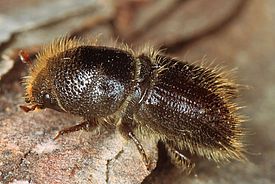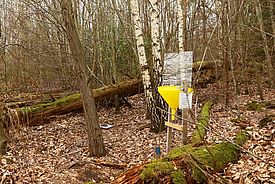On the morning of 26 December 1999, windstorm Lothar swept across Switzerland, flattening 12.7 million cubic metres of timber. The damage to the forest amounted to an estimated CHF 1 billion, including the consequences of subsequent beetle infestations. However, 20 years on, researchers from the Swiss Federal Institute for Forest, Snow and Landscape Research (WSL) also see some positive effects. For example, at lower elevations species-rich, mixed deciduous forests containing primarily climate-robust trees have emerged.
For centuries, silviculture was the force that shaped Switzerland's forests, but windstorm Lothar made the public aware of how exceptional natural events can affect them, too. "In a few hours, fierce winds had changed many forests more profoundly than forestry operations could have done in two to three years", says forest ecologist Thomas Wohlgemuth (WSL). Three years later, in 2003, a dry, hot summer weakened many trees and prompted record reproduction levels among bark beetles, which infested drought-stricken stands of spruce. Switzerland as a whole escaped subsequent windstorms (Kyrill in 2007 and Burglind and Vaia in 2018) largely unscathed, though the northern and eastern parts of the country were once again badly hit. Another dry summer, in 2018, led to a further severe bark beetle infestation of the already weakened spruce trees.
Windthrows attract bark beetles
When powerful storms uproot forests over large areas, spruce-rich stands almost invariably suffer calamitous bark beetle infestation. After Lothar, studies conducted by ETH Zurich and WSL showed that further infestation could be mitigated by rapidly clearing windthrown timber and making early use of any standing spruce hosting bark beetle populations. For although predatory and parasitic insects multiply rapidly when more bark beetles are present, these natural enemies do not prevent spruce tree infestation, only slow it down. In the coming decades, entomologist Beat Wermelinger (WSL) expects climate change to make forests even more susceptible to insect infestation than in the past: "For instance, in dry years we may even see three, rather than two, beetle populations develop on the Swiss Plateau attacking weakened spruce trees". In turn, long-term WSL studies also showed that insect diversity increased significantly in the first years after the storm, but that species numbers decreased again as reforestation progressed.
In some places barely a single tree remained standing
Where windstorm Lothar blew at speeds of 200 km/h and more on St Stephen's Day back in 1999, barely a single tree remained standing. The effect of the hurricane gusts was particularly great because it was relatively warm during the storm, the forest soils were not frozen and rain softened the soils. Therefore, trees and their root plates were more often knocked over than broken. Furthermore, in stormy conditions tall coniferous trees offer greater wind resistance than smaller deciduous trees, which do not have leaves in winter. Accordingly, forest ecologist Wohlgemuth is convinced that: "Shorter forest lifecycles could reduce the risk of windthrow, making many trees smaller and more stable".
Species-rich, climate-robust forests
Today, young trees 10 to 15 m tall are growing where the forest was flattened 20 years ago. WSL research shows that after the storm, pioneer trees such as willows, birches and rowanberries as well as tree species that dominated before the storm generally predominate. On the Swiss Plateau and in the Alpine foothills the predominant species growing back is beech, whereas spruce tends to preponderate at higher elevations. That said, our forests are now home to more species than before. "There are many indications that climate-robust forests are growing back here, containing additional species, like oak, cherry and maple", says senior forest scientist Peter Brang (WSL). For these tree species are more drought-tolerant than beech and spruce, surprisingly indicating that catastrophic disturbances can have a stabilising effect in the long term.
If regeneration is sparse, the question arises as to whether specific desired tree species ought to be planted. WSL's research on the windstorm Lothar has shown that diverse deciduous forests form in large, storm-hit sites 'troop'-planted with climate-adapted deciduous tree species, such as oak, because many other tree species establish themselves between the planted tree groups. Troop planting is inexpensive and achieves the intended objective faster than entirely naturally occurring young forest.
Avalanche barriers and planting in protected forests?
Sources of extensive disturbances, like windstorm Lothar, can immediately undermine the degree of protection offered by a mountain forest. Forest ecologist Peter Bebi (SLF) knew from experience and research into windstorm Vivian that toppled trees and uprooted root plates can help to provide protection against rockfalls or erosion, at least during the first few years after a storm. "The long-term impact was still largely unknown at the time", he says.
“Recent research work on windthrow areas has confirmed that the increased roughness of the mountain slopes due to lying dead trees and root plates in mountain forests often has a long-term effect against avalanches and rockfall,” says Bebi. Especially when the slopes are not extremely steep and reforestation takes place quickly thanks to young trees already existing before the storm. In the event that these are not yet available or are slow to emerge, technical safety measures and the plantings of target tree species have proved effective, especially in steep and high protection forests.
Lessons learned from storms and other disturbances
There is no doubt that Lothar was an extreme event for the forestry industry, causing economic losses totalling some CHF 1 billion including bark beetle damage. However, the sequence of natural events, from storms Vivian and Lothar to the 2003 forest fire in Leuk and the droughts in 2003 and 2018, has made it clear that such occurrences are becoming increasingly commonplace.
“The findings from forestry practice and research after the storms helped to provide a clearer understanding of natural forest dynamics and recognise that disturbances constitute opportunities for swift adaptation,” stresses Wohlgemuth. If, as expected, the climate becomes significantly warmer and drier, trees can be expected to die off repeatedly over large areas, due to storms, drought, insect infestations or forest fires. The composition of tree species in forests should slowly change thereafter. However, it is questionable whether forests will be able to keep up with the rapid pace of climate change.






At higher elevations, fallen trees play a certain role in rejuvenating the substrate because young spruce trees like growing on them, whereas at lower elevations dead wood plays no role in forest rejuvenation. However, in the past 20 years the significance of dead wood as an important habitat for up to 3,000 species of animals, fungi and bacteria has become increasingly apparent. Consequently, this substrate has come to be regarded as indispensable in both silviculture and nature conservation. So storms first produce dead wood, but then life. Today this is common knowledge, but before storm Lothar only few people were aware of it.
Contact ¶
Links ¶
Copyright ¶
WSL und SLF stellen Bildmaterial zur Bebilderung von Presseartikeln im Zusammenhang mit dieser Medienmitteilung kostenfrei zur Verfügung. Eine Übernahme der Bilder in Bilddatenbanken und ein Verkauf der Bilder durch Dritte sind nicht gestattet.






